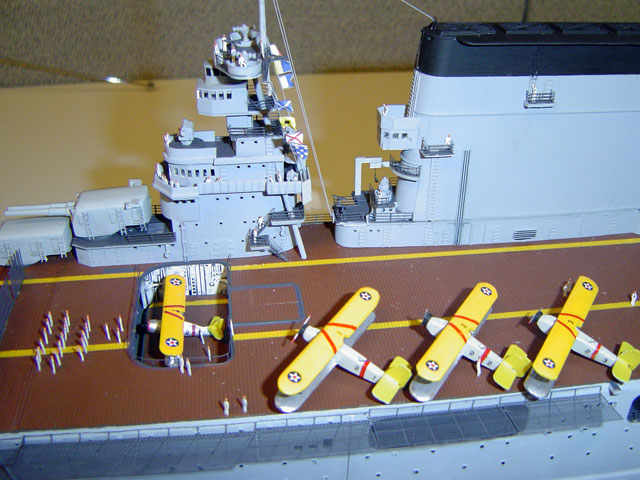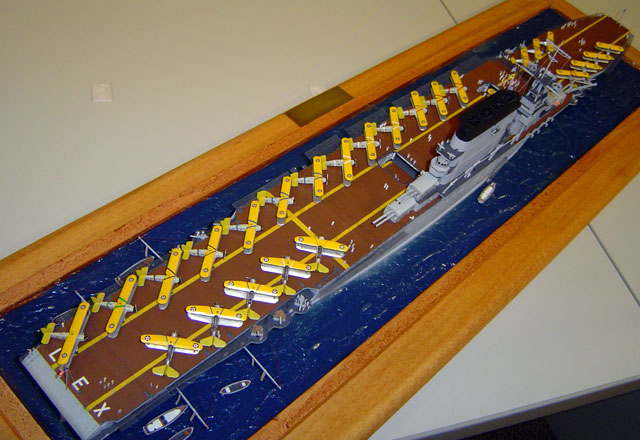|
Trumpeter's 1/350 scale
USS Lexington CV-2
by
Rick Cotton
|
 |
|
USS
Lexington |

Trumpeter's
1/350 USS Lexington is available online from Squadron
Ah, the prewar Navy of the
1930’s. Clean, light gray ships, yellow-wing biplanes, palm trees and
exotic ports-of-call. Showing the flag at picturesque harbors. What a
beautiful era.
With visions of Fred
MacMurray and Errol Flynn pushing a brightly painted Vindicator over
into a Hollywood nose dive, I opened Trumpeter’s 1/350th scale Lexington
kit and…… Ye Gods!!! Horror! No Vindicators! No 8” guns! No streamlined,
tapered flight deck! Aaaauugghhh! Oh, the humanity!
Construction /
Conversion
|
Okay, maybe I overreacted
a bit. The task was really quite simple: to get the prewar Gray Lady I
love, the flight deck had to be cut down, the openings for all those
extra post-1936 guns had to be filled, the scalloped openings at the aft
end of the flight deck had to be filled, the extra bridge layer whacked
off, aft fire-control platforms scratchbuilt, minor changes to the
funnel and it’s platforms, the boat deck, and …oh, yes…the air group.
Now, let’s see, just who (as of this writing) makes 1930’s Navy biplanes
in 1/350th?
Hmmm,….almost….NOBODY! I considered begging a set of bipes from the Blue
Water Navy USS Langley kit, but decided against it, as these were
earlier aircraft than I wanted. I finally ended up scratchbuilding 14
Martin T4M torpedo planes (easier than it sounds to build these
slab-sided torpedo trucks), and converting Trumpeter F4F’s to F3F’s
(fairly simple) and SB2C’s to SBC’s (not simple). More on the historical
accuracy (?) of the air group later.

The flight deck was placed upside-down on a flat surface,and the hull
was placed against it for tracing. The deck was cut to match the hull,
and the offending post-1936 gun platforms were sheeted over, filled and
sanded away,as were the scalloped openings at the aft end of the flight
deck. This area was filled and re-scribed to match the deck planking.
Assembly of the hull proceeded in a mostly straightforward fashion. Fit
was pretty good, with only minor problems,such as the warped tops of the
boat wells on the sides of the hull. This was fixed by careful gluing
and clamping during assembly. Tenax 7R served me well, as it always
does. I cannot recommend it too strongly as a liquid cement.
On to Lady Lex’s most distinctive feature…the massive funnel and island.
The after fire control platforms were scratchbuilt…at the time this was
my only option. I razor-sawed off the extra bridge layer, and glassed-in
all the square windows on the assembly. There is also another small
level above the forward FCP that isn’t supplied in the kit. I carved one
from a chunk of spare resin. The rangefinder was pirated from an Arizona
kit,and the masts were reinforced with thin piano wire. The bridge deck
and associated platforms were re-worked with thin sheet styrene. Nearly
all molded splinter shields came off, to be replaced with Tom’s
Modelworks brass photoetch railing. The gallery at the top of the funnel
was deleted, and minor changes were made to most platforms. Gold Medal
Models figures populated the island.

Just as I was starting to sweat over the thought of scratchbuilding four
8” turrets, along comes Yankee Modelworks to the rescue with a 1938
backdate set, including the necessary 8” artillery. The parts are nicely
cast, requiring only minor cleanup. Much of what was included in the set
had already been done the hard way by impatient me, but, no big deal,
I’ll use the rest of the parts someday. Suffice it to say that the set
is excellent and comprehensive.
All vertical surfaces were
sprayed with a custom mixed version of prewar Standard Navy Gray (mixed
from Pollyscale Acrylics). The decks, other than the flight deck, were
sprayed with a slightly lightened Pollyscale Acrylic Scale Black (really
a very dark gray). I shot the flight deck with Pollyscale Acrylic
Leather, and the stripes are Testors’ gloss Yellow. The “LEX” decals
came from the spares box.
A note on the air group….this is a model in transition. As I get more
info on what was actually aboard Lex in 1935-36, I will probably change
the aircraft. SBC’s didn’t show up until AT LEAST 1936, and the T4M’s
had probably disappeared by that time. Of course, should some wonderful
manufacturer start cranking out Berliner-Joyce’s and Boeing F4B’s…I’ll
gladly plunk down the cash…maybe I can scratchbuild some….maybe I’m
nuts. Anyway, at that time, the SBC’s can migrate to a 1940 Yorktown.

Lex was launched into a “sea” of clear acrylic caulk, over a
deep-blue-painted base. One can just imagine a line of cage-masted
battlewagons slowly filing by in review. Those BB’s would be officered
by young ensigns, lieutenants and captains, with names like Mitscher,
Spruance, and Halsey. Lexington may be long gone to her deep sleep in
the Pacific,but her memory lives on in my display case,a reminder of a
glorious time, aboard a beautiful ship.
Click on the thumbnails
below to view larger images:
Model, Images and Text Copyright ©
2005 by Rick Cotton
Page Created 28 September, 2005
Last Updated
27 September, 2005
Back to
HyperScale Main Page |
Home
| What's New |
Features |
Gallery |
Reviews |
Reference |
Forum |
Search